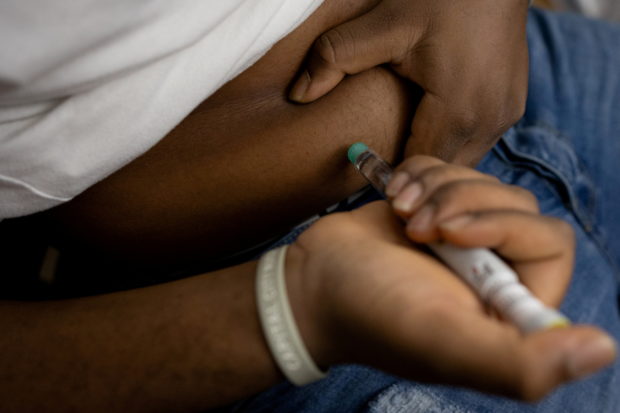Diabetes surges among American youth, study shows

Type 2 diabetes patient Adedotun Adebayo (15) gives himself an insulin shot before eating dinner at his home in Glenarden, Maryland, U.S., July 15, 2021. REUTERS FILE PHOTO
The number of young people with the most prevalent form of diabetes nearly doubled in the United States from 2001 to 2017, according to a study published on Tuesday.
The findings showed that the rate of young people ages 10 to 19 with type 2 diabetes increased by 95% over the 16-year period. The estimated rate of youth under age 20 with type 1 diabetes grew by 45%.
“Rising rates of diabetes, particularly type 2 diabetes, which is preventable, has the potential to create a cascade of poor health outcomes,” said Dr Giuseppina Imperatore, who oversees disease surveillance and other areas at the U.S. Centers for Disease Control and Prevention’s Division of Diabetes Translation.
This month, Reuters published a special report on the worsening outcomes for people with diabetes in the United States.
The new findings come from the SEARCH for Diabetes in Youth study, which was funded by the CDC and the National Institutes of Health (NIH).
Article continues after this advertisementOne in 10 Americans, or 34 million people, have diabetes in the United States. About 1.6 million people have type 1 diabetes, an autoimmune disease of unknown cause that requires insulin injections when the pancreas stops producing the hormone. Millions more have type 2 diabetes, a chronic condition in which the body either doesn’t produce enough insulin or doesn’t use it well.
Article continues after this advertisementResearchers found significant increases in diabetes among both sexes and across racial and ethnic groups.
Type 1 diabetes remains more common among white youth. Larger increases in type 2 prevalence were found among young people who are Black or Hispanic, according to the study published in JAMA. The highest rates of type 2 diabetes were seen in youth who are Black or Native American.
Jean M. Lawrence, the paper’s lead author and director of the NIH’s diabetes epidemiology program, said more research is needed to better understand what’s driving these increases.
“Increasing prevalence of type 2 diabetes could be caused by rising rates of childhood obesity, in-utero exposure to maternal obesity and diabetes, or increased diabetes screenings,” Lawrence said.
The COVID-19 pandemic also hit people with diabetes particularly hard, including those who never got sick from the virus but fell victim to the isolation and disruption it caused.
Reuters in the Special Report found that deaths from diabetes last year surged 17% to more than 100,000. Younger people, those ages 25 to 44, suffered the sharpest increase, with a 29% jump in deaths. By comparison, all other deaths except those directly attributed to the coronavirus rose 6% last year, Reuters found.
Also on Tuesday, a U.S. government-backed panel of experts in disease prevention recommended that overweight or obese adults should be screened for prediabetes and type 2 diabetes starting at age 35, lowering the age by five years.